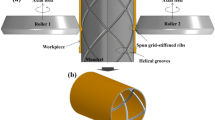Abstract
How to form high-quality transverse inner ribs through power spinning is a key issue for complicated integrated curved generatrix parts with transverse inner ribs. In this study, the forming characteristics and laws during the power spinning process were investigated using a finite element simulation based on the orthogonal design method. The results show that the transverse inner rib distributes homogeneously along the circumferential direction but inhomogeneously along the generatrix direction. Depressions occur easily in the middle zone of the rib (MZR). The roller nose radius is the most significant parameter of the MZR underfill degree. A larger roller nose radius is helpful to decrease the MZR underfill degree. Furthermore, the preformed billet thickness also plays a vital role in the underfill degree of the front zone of the rib and the back zone of the rib, as well as the depression degree of the outer surface of the rib. By combining the rib-filling characteristics and laws, the optimized forming process window for obtaining high-quality inner ribs was obtained by regression analysis, thus laying a basis for improving the forming quality of curved generatrix parts with transverse inner ribs in power spinning.

















Similar content being viewed by others

References
Zhan M, Guo J, Fu MW et al (2018) Formability limits and process window based on fracture analysis of 5A02-O aluminium alloy in splitting spinning. J Mater Process Technol 257:15–32
Music O, Allwood JM, Kawai K (2010) A review of the mechanics of metal spinning. J Mater Process Technol 210(1):3–23
Zhan M, Chu Q, Shi F et al (2014) Forming law of flexible hot spinning of TA15 titanium alloy. J Netshape Form Eng 6(5):31–36
Wong CC, Dean TA, Lin J (2003) A review of spinning, shear forming and flow forming process. Int J Mach Tool Manuf 43(14):1419–1435
Bai Q, He Y, Zhan M (2008) Finite element modeling of power spinning of thin-walled shell with hoop inner rib. Trans Nonferrous Met Soc China 18:6–13
Ma F, Yang H, Zhan M (2007) Research on distribution of stress and strain field in power spinning process of parts with transverse rib. In: The fifth international conference on physical and numerical simulation of materials processing (ICPNS 2007), Zhengzhou, China, vol 6, pp 866–868
Ma F, Yang H, Zhan M (2007) Research on the blank selection in the power spinning process of parts with transverse inner rib. Mater Forum Sci 561–565:885–888
Ma F, Yang H, Zhan M (2010) Plastic deformation behaviors and their application in power spinning process of conical parts with transverse inner rib. J Mater Process Technol 210(1):180–189
Jiang SY, Ren ZY, Xue KM et al (2008) Application of BPANN for prediction of backward ball spinning of thin-walled tubular part with longitudinal inner ribs. J Mater Process Technol 196(1–3):190–196
Wang Z, Ma S (2016) Analysis of thin-walled shells with inner ribs formed by inner spinning technology. Mater Res Innov 19(s5):101–105
Liang W, Cao ZP, Li XG et al (2016) The study on spin forming technology of tube shaped parts with circumferential reinforcements. J Changchun Univ Sci Technol (Nat Sci Edn) 39(5):85–87
Zhan M, Li H, Yang H et al (2008) Wall thickness variation during multi-pass spinning of large complicated shell. J Plast Eng 15(2):115–121
Chen G, Zhan M, Yang H et al (2008) FEA of power spinning of complicated thin-walled shell based on orthogonal optimization. J Plast Eng 15(4):67–71
Luo W, Chen F, Xu B et al (2018) Study on compound spinning technology of large thin-walled parts with ring inner ribs and curvilinear generatrix. Int J Adv Manuf Technol 98(5–8):1199–1216
Gu CG (2010) Research on inhomogeneous deformation during spinning of curvilinear generatrix thin-walled shell with transverse inner rib. Dissertation, Northwestern Polytechnical University
Acknowledgements
The authors acknowledge the funding support from the National Science Fund for Distinguished Young Scholars of China (Grant No. 51625505), the Key Program Project of the Joint Fund of Astronomy and the National Natural Science Foundation of China (Grant No. U1537203) and the Open Research Fund of State Key Laboratory of High Performance Complex Manufacturing, Central South University.
Author information
Authors and Affiliations
Corresponding author
Rights and permissions
About this article
Cite this article
Zhang, HR., Zhan, M., Guo, J. et al. Forming the transverse inner rib of a curved generatrix part through power spinning. Adv. Manuf. 7, 105–115 (2019). https://doi.org/10.1007/s40436-018-0241-x
Received:
Accepted:
Published:
Issue Date:
DOI: https://doi.org/10.1007/s40436-018-0241-x



